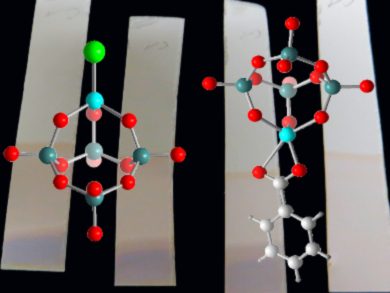Anions play important roles in everything from biological and chemical processes through to environmental pollution. There have been decades of research concerned with the development of small molecule anion sensors.
Carsten Streb, Ulm University, Germany, and colleagues have developed an anion sensor compound based on a polyoxometalate (POM) cluster. Ion sensing using POMs has mainly been focused on their redox activity, and homogenous sensing is usually used for cations due to the anionic nature of the POM clusters. The cobalt vanadate POM cluster synthesized by the team has a cobalt-based anion coordination site, allowing its application as an anion sensor. Different anions bound to the cobalt vanadate in solution give rise to slightly altered structures (examples pictured), and these differences can be easily probed using UV/Vis spectroscopy.
The detection response is good for a wide range of anions, and the system can even distinguish between chemically related groups of anions such as the different halides. It even proved possible to create dip-stick sensors for acetate anions, with an easy to observe brown to blue color change upon detection.
- Homogeneous and Heterogeneous Anion Sensing by a Molecular Cobalt-Vanadium Oxide,
Magdalena Heiland, Andrey Seliverstov, Benjamin Schwarz, Montaha H. Anjass, Carsten Streb,
Chem. Eur. J. 2017.
DOI: 10.1002/chem.201605392




